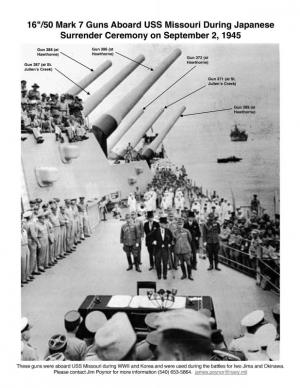USS Missouri gun at Fort Miles nearly lost for scrap metal
.jpg)
Thanks to the Cape Gazette for publishing my Rehoboth Beach Patrol buddy Woody Marderwald’s piece dealing with rescuing the big guns of the USS Missouri.
The public doesn’t know how close we came to losing those guns – the last three out of 36 original main barrels from our four World War II Iowa-class battleships which had not yet been melted down for scrap metal. Each one cost $1million to build during World War II.
Scrap drives were held during the war to help secure metal and other building materials for the country’s defense needs. Scrap metal certainly went into those big guns, and in the shadow of the three mentioned here, the Japanese signed the surrender agreement in Tokyo Bay, Sept. 2, 1945.
But turning the guns back into scrap – sacrilege! An attached photo shows the Japanese surrender. Look at the size of the guns and the turrets. Each turret, without any guns, weighed as much as a destroyer. Three of the guns were depicted in a previous Cape Gazette article photo of us holding a photo of the Allied victory flyover of Tokyo right after the surrender.
The March 1 Cape Gazette article was a team effort and, among various things, I contributed the photographs, except for the iconic one taken by Ron MacArthur as our big gun crossed the Lewes-Rehoboth Canal swing bridge, which was recently removed after having been an important part of the Lewes landscape for over a century.
In order to demonstrate how close we came to losing these last three guns, I have included a photo of myself with a WWII U.S. Marine veteran who was on board the Missouri during the Japanese surrender. He attended the second celebration after the gun arrived at Fort Miles.
It turns out that a certain number of copies of the surrender document were made on board the battleship on the same day as the surrender. Our Marine friend obtained a copy, and that is what we are unrolling next to the muzzle of the big gun.
If you look carefully, you can see an orange stripe painted on the gun barrel just in front of the Marine’s face. That was one of the places on the gun which were targeted for the cutting to occur. It’s a pretty frightening thought, and it hit hard when we learned about it. Our gun and the last two others which had been saved were literally rescued from the grave.
When we were trying to raise money to conduct the rescues, a little boy who had just had his fifth birthday gave us his $5 bill birthday present. It made me feel terrible, and I thanked him but asked that he keep the money and have a good time. He was insistent, however, and there was no way we could turn down his remarkable gift. Probably the most money he had ever seen. We got his name for recognition and sincerely thanked him. But his insistence as well as his vision really shook me up. Part of something I had been saying which Dr. Gary Wray picked up on: “The spirit that won the war!” That young man would now be about 15 years old. I hope he remembers our gratitude and comes to visit Fort Miles. I would certainly like to meet him again. If more people were like him, I think we would have a lot fewer wars and other conflicts.
Believe me, we came very close to not raising all the required money to move the guns away from Norfolk before they could be destroyed. We are grateful to the many who contributed financial and other assistance, including help with securing funds to mount the gun where it now stands proudly overlooking the sea at Fort Miles. And a special thanks to Dr. Gary Wray, whose vision and hard work with others produced a number of miracles for which we all should be grateful.






















































